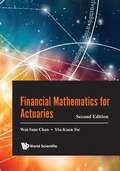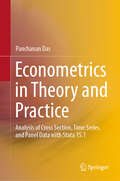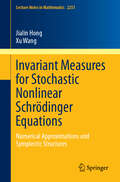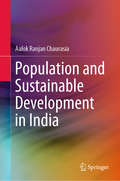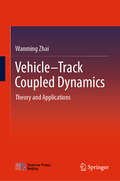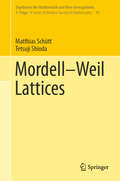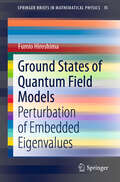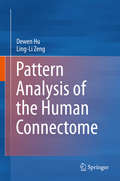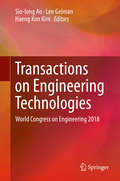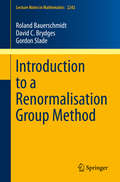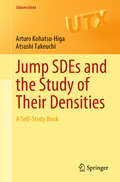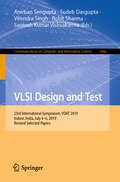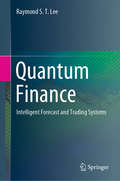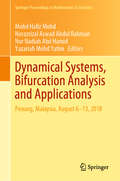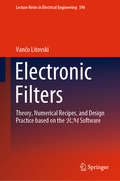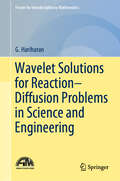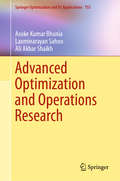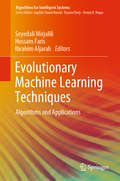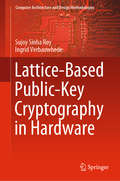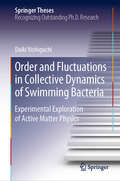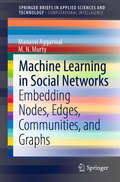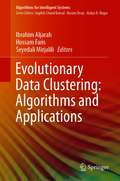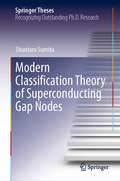- Table View
- List View
Financial Mathematics For Actuaries (Second Edition)
by Wai-Sum Chan Yiu-Kuen TseFinancial Mathematics for Actuaries is a textbook for students in actuarial science, quantitative finance, financial engineering and quantitative risk management and is designed for a one-semester undergraduate course. <P><P> Covering the theories of interest rates, with applications to the evaluation of cash flows, the pricing of fixed income securities and the management of bonds, this textbook also contains numerous examples and exercises and extensive coverage of various Excel functions for financial calculation. Discussions are linked to real financial market data, such as historical term structure, and traded financial securities. <P><P> The topics discussed in this book are essential for actuarial science students. They are also useful for students in financial markets, investments and quantitative finance. Students preparing for examinations in financial mathematics with various professional actuarial bodies will also find this book useful for self-study. <P><P> In this second edition, the recent additions in the learning objectives of the Society of Actuaries Exam FM have been covered.
Econometrics in Theory and Practice: Analysis of Cross Section, Time Series and Panel Data with Stata 15.1
by Panchanan DasThis book introduces econometric analysis of cross section, time series and panel data with the application of statistical software. It serves as a basic text for those who wish to learn and apply econometric analysis in empirical research. The level of presentation is as simple as possible to make it useful for undergraduates as well as graduate students. It contains several examples with real data and Stata programmes and interpretation of the results. While discussing the statistical tools needed to understand empirical economic research, the book attempts to provide a balance between theory and applied research. Various concepts and techniques of econometric analysis are supported by carefully developed examples with the use of statistical software package, Stata 15.1, and assumes that the reader is somewhat familiar with the Strata software. The topics covered in this book are divided into four parts. Part I discusses introductory econometric methods for data analysis that economists and other social scientists use to estimate the economic and social relationships, and to test hypotheses about them, using real-world data. There are five chapters in this part covering the data management issues, details of linear regression models, the related problems due to violation of the classical assumptions. Part II discusses some advanced topics used frequently in empirical research with cross section data. In its three chapters, this part includes some specific problems of regression analysis. Part III deals with time series econometric analysis. It covers intensively both the univariate and multivariate time series econometric models and their applications with software programming in six chapters. Part IV takes care of panel data analysis in four chapters. Different aspects of fixed effects and random effects are discussed here. Panel data analysis has been extended by taking dynamic panel data models which are most suitable for macroeconomic research. The book is invaluable for students and researchers of social sciences, business, management, operations research, engineering, and applied mathematics.
Invariant Measures for Stochastic Nonlinear Schrödinger Equations: Numerical Approximations and Symplectic Structures (Lecture Notes in Mathematics #2251)
by Jialin Hong Xu WangThis book provides some recent advance in the study of stochastic nonlinear Schrödinger equations and their numerical approximations, including the well-posedness, ergodicity, symplecticity and multi-symplecticity. It gives an accessible overview of the existence and uniqueness of invariant measures for stochastic differential equations, introduces geometric structures including symplecticity and (conformal) multi-symplecticity for nonlinear Schrödinger equations and their numerical approximations, and studies the properties and convergence errors of numerical methods for stochastic nonlinear Schrödinger equations.This book will appeal to researchers who are interested in numerical analysis, stochastic analysis, ergodic theory, partial differential equation theory, etc.
Population and Sustainable Development in India
by Aalok Ranjan ChaurasiaThis book addresses central issues related to population and sustainable development in India, the second most populous country in the world. Using the latest available source of data in the context of the United Nations 2030 Sustainable Development Agenda, it analyzes the current state of development in India in terms of economic growth, social inclusion, and environmental protection, especially focusing on the role of population. The respective chapters explore various aspects, but mainly focus on promoting greater sustainability in terms of population growth, child survival, and economic growth. As such, the book will be of interest to students, researchers, and policymakers in the fields of population studies, economics, and international development.
Vehicle–Track Coupled Dynamics: Theory and Applications
by Wanming ZhaiThis book systematically presents the theory, numerical implementation, field experiments and practical engineering applications of the ‘Vehicle–Track Coupled Dynamics’. Representing a radical departure from classic vehicle system dynamics and track dynamics, the vehicle–track coupled dynamics theory considers the vehicle and track as one interactive and integrated system coupled through wheel–rail interaction. This new theory enables a more comprehensive and accurate solution to the train–track dynamic interaction problem which is a fundamental and important research topic in railway transportation system, especially for the rapidly developed high-speed and heavy-haul railways. It has been widely applied in practical railway engineering.Dr. Wanming Zhai is a Chair Professor of Railway Engineering at Southwest Jiaotong University, where he is also chairman of the Academic Committee and Director of the Train and Track Research Institute. He is a member of the Chinese Academy of Sciences and one of the leading scientists in railway system dynamics. Professor Zhai is Editor-in-Chief of both the International Journal of Rail Transportation, published by Taylor & Francis Group, and the Journal of Modern Transportation, published by Springer. In addition, he is a trustee of the International Association for Vehicle System Dynamics, Vice President of the Chinese Society of Theoretical and Applied Mechanics, and Vice President of the Chinese Society for Vibration Engineering.
Asianization of Migrant Workers in the Gulf Countries
by S. Irudaya Rajan Ginu Zacharia OommenThis edited volume contains sixteen chapters by eminent scholars on one of the largest migration corridors in the world i.e., between South and South-East Asia and the Gulf region. Asia’s trade and cultural contact with the Gulf date back to ancient historical times. Since the 1970s, the economic rise of the Gulf Cooperation Council (GCC) countries owing to the discovery of oil has inspired a huge influx of migrant workers from Asia. At present, out of roughly 15 million expatriates in the Gulf region, Asians constitute around 12 million (80 percent). The chapters in this book look at migration from countries like India, Sri Lanka, Bangladesh, Pakistan, Indonesia and Philippines to the different GCC countries. A few chapters also focus on migration from the India state of Kerala- a state where migration to the Gulf is prominent and where remittances make up over 36 percent of the state GDP. Furthermore, the issues covered range from labour practices and policies, citizenship and state protection, human rights, gender and caste as well as diaspora. This book explores the multifaceted nuances of the ‘Asia-Gulf migratory corridor’ and unearths future prospects and strategic implications. The book examines remittance behaviour, changing gender roles of immigrants, social-spatial mobility, migrant policies, human rights, sense of belonging and identity and perception, and the interaction between nationals and non-nationals. The book will be of interest to researchers in the areas of demography, migration and gender studies as well as social science researchers, policy makers, human rights lawyers, civil society institutions working on migration, Gulf studies programmes and centres on South-Asian and Middle-Eastern studies.
Mordell–Weil Lattices (Ergebnisse der Mathematik und ihrer Grenzgebiete. 3. Folge / A Series of Modern Surveys in Mathematics #70)
by Matthias Schütt Tetsuji ShiodaThis book lays out the theory of Mordell–Weil lattices, a very powerful and influential tool at the crossroads of algebraic geometry and number theory, which offers many fruitful connections to other areas of mathematics. The book presents all the ingredients entering into the theory of Mordell–Weil lattices in detail, notably, relevant portions of lattice theory, elliptic curves, and algebraic surfaces. After defining Mordell–Weil lattices, the authors provide several applications in depth. They start with the classification of rational elliptic surfaces. Then a useful connection with Galois representations is discussed. By developing the notion of excellent families, the authors are able to design many Galois representations with given Galois groups such as the Weyl groups of E6, E7 and E8. They also explain a connection to the classical topic of the 27 lines on a cubic surface.Two chapters deal with elliptic K3 surfaces, a pulsating area of recent research activity which highlights many central properties of Mordell–Weil lattices. Finally, the book turns to the rank problem—one of the key motivations for the introduction of Mordell–Weil lattices. The authors present the state of the art of the rank problem for elliptic curves both over Q and over C(t) and work out applications to the sphere packing problem. Throughout, the book includes many instructive examples illustrating the theory.
Ground States of Quantum Field Models: Perturbation of Embedded Eigenvalues (SpringerBriefs in Mathematical Physics #35)
by Fumio HiroshimaThis book provides self-contained proofs of the existence of ground states of several interaction models in quantum field theory. Interaction models discussed here include the spin-boson model, the Nelson model with and without an ultraviolet cutoff, and the Pauli–Fierz model with and without dipole approximation in non-relativistic quantum electrodynamics. These models describe interactions between bose fields and quantum mechanical matters.A ground state is defined as the eigenvector associated with the bottom of the spectrum of a self-adjoint operator describing the Hamiltonian of a model. The bottom of the spectrum is however embedded in the continuum and then it is non-trivial to show the existence of ground states in non-perturbative ways. We show the existence of the ground state of the Pauli–Fierz mode, the Nelson model, and the spin-boson model, and several kinds of proofs of the existence of ground states are explicitly provided. Key ingredients are compact sets and compact operators in Hilbert spaces. For the Nelson model with an ultraviolet cutoff and the Pauli–Fierz model with dipole approximation we show not only the existence of ground states but also enhanced binding. The enhanced binding means that a system for zero-coupling has no ground state but it has a ground state after turning on an interaction.The book will be of interest to graduate students of mathematics as well as to students of the natural sciences who want to learn quantum field theory from a mathematical point of view. It begins with abstract compactness arguments in Hilbert spaces and definitions of fundamental facts of quantum field theory: boson Fock spaces, creation operators, annihilation operators, and second quantization. This book quickly takes the reader to a level where a wider-than-usual range of quantum field theory can be appreciated, and self-contained proofs of the existence of ground states and enhanced binding are presented.
Pattern Analysis of the Human Connectome
by Dewen Hu Ling-Li ZengThis book presents recent advances in pattern analysis of the human connectome. The human connectome, measured by magnetic resonance imaging at the macroscale, provides a comprehensive description of how brain regions are connected. Based on machine learning methods, multiviarate pattern analysis can directly decode psychological or cognitive states from brain connectivity patterns. Although there are a number of works with chapters on conventional human connectome encoding (brain-mapping), there are few resources on human connectome decoding (brain-reading). Focusing mainly on advances made over the past decade in the field of manifold learning, sparse coding, multi-task learning, and deep learning of the human connectome and applications, this book helps students and researchers gain an overall picture of pattern analysis of the human connectome. It also offers valuable insights for clinicians involved in the clinical diagnosis and treatment evaluation of neuropsychiatric disorders.
Transactions on Engineering Technologies: World Congress on Engineering 2018 (Lecture Notes In Electrical Engineering Ser. #275)
by Sio-Iong Ao Len Gelman Haeng Kon KimThis volume contains a selection of revised and extended research articles written by prominent researchers participating in The 26th World Congress on Engineering (WCE 2018) which was held in London, U.K., July 4-6, 2018. Topics covered include engineering mathematics, electrical engineering, communications systems, computer science, chemical engineering, systems engineering, manufacturing engineering, and industrial applications. With contributions carefully chosen to represent the most cutting-edge research presented during the conference, the book contains some of the state-of-the-art in engineering technologies and the physical sciences and their applications, and serves as a useful reference for researchers and graduate students working in these fields.
Introduction to a Renormalisation Group Method (Lecture Notes in Mathematics #2242)
by Roland Bauerschmidt David C. Brydges Gordon SladeThis is a primer on a mathematically rigorous renormalisation group theory, presenting mathematical techniques fundamental to renormalisation group analysis such as Gaussian integration, perturbative renormalisation and the stable manifold theorem. It also provides an overview of fundamental models in statistical mechanics with critical behaviour, including the Ising and φ4 models and the self-avoiding walk. The book begins with critical behaviour and its basic discussion in statistical mechanics models, and subsequently explores perturbative and non-perturbative analysis in the renormalisation group. Lastly it discusses the relation of these topics to the self-avoiding walk and supersymmetry. Including exercises in each chapter to help readers deepen their understanding, it is a valuable resource for mathematicians and mathematical physicists wanting to learn renormalisation group theory.
Jump SDEs and the Study of Their Densities: A Self-Study Book (Universitext)
by Arturo Kohatsu-Higa Atsushi TakeuchiThe present book deals with a streamlined presentation of Lévy processes and their densities. It is directed at advanced undergraduates who have already completed a basic probability course. Poisson random variables, exponential random variables, and the introduction of Poisson processes are presented first, followed by the introduction of Poisson random measures in a simple case. With these tools the reader proceeds gradually to compound Poisson processes, finite variation Lévy processes and finally one-dimensional stable cases. This step-by-step progression guides the reader into the construction and study of the properties of general Lévy processes with no Brownian component. In particular, in each case the corresponding Poisson random measure, the corresponding stochastic integral, and the corresponding stochastic differential equations (SDEs) are provided. The second part of the book introduces the tools of the integration by parts formula for jump processes in basic settings and first gradually provides the integration by parts formula in finite-dimensional spaces and gives a formula in infinite dimensions. These are then applied to stochastic differential equations in order to determine the existence and some properties of their densities. As examples, instances of the calculations of the Greeks in financial models with jumps are shown. The final chapter is devoted to the Boltzmann equation.
VLSI Design and Test: 23rd International Symposium, VDAT 2019, Indore, India, July 4–6, 2019, Revised Selected Papers (Communications in Computer and Information Science #1066)
by Rohit Sharma Virendra Singh Sudeb Dasgupta Anirban Sengupta Santosh Kumar VishvakarmaThis book constitutes the refereed proceedings of the 23st International Symposium on VLSI Design and Test, VDAT 2019, held in Indore, India, in July 2019. The 63 full papers were carefully reviewed and selected from 199 submissions. The papers are organized in topical sections named: analog and mixed signal design; computing architecture and security; hardware design and optimization; low power VLSI and memory design; device modelling; and hardware implementation.
Quantum Finance: Intelligent Forecast and Trading Systems
by Raymond S. LeeWith the exponential growth of program trading in the global financial industry, quantum finance and its underlying technologies have become one of the hottest topics in the fintech community. Numerous financial institutions and fund houses around the world require computer professionals with a basic understanding of quantum finance to develop intelligent financial systems. This book presents a selection of the author’s past 15 years’ R&D work and practical implementation of the Quantum Finance Forecast System – which integrates quantum field theory and related AI technologies to design and develop intelligent global financial forecast and quantum trading systems. The book consists of two parts: Part I discusses the basic concepts and theories of quantum finance and related AI technologies, including quantum field theory, quantum price fields, quantum price level modelling and quantum entanglement to predict major financial events. Part II then examines the current, ongoing R&D projects on the application of quantum finance technologies in intelligent real-time financial prediction and quantum trading systems. This book is both a textbook for undergraduate & masters level quantum finance, AI and fintech courses and a valuable resource for researchers and data scientists working in the field of quantum finance and intelligent financial systems. It is also of interest to professional traders/ quants & independent investors who would like to grasp the basic concepts and theory of quantum finance, and more importantly how to adopt this fascinating technology to implement intelligent financial forecast and quantum trading systems. For system implementation, the interactive quantum finance programming labs listed on the Quantum Finance Forecast Centre official site (QFFC.org) enable readers to learn how to use quantum finance technologies presented in the book.
Dynamical Systems, Bifurcation Analysis and Applications: Penang, Malaysia, August 6–13, 2018 (Springer Proceedings in Mathematics & Statistics #295)
by Mohd Hafiz Mohd Norazrizal Aswad Abdul Rahman Nur Nadiah Abd Hamid Yazariah Mohd YatimThis book is the result of Southeast Asian Mathematical Society (SEAMS) School 2018 on Dynamical Systems and Bifurcation Analysis (DySBA). It addresses the latest developments in the field of dynamical systems, and highlights the importance of numerical continuation studies in tracking both stable and unstable steady states and bifurcation points to gain better understanding of the dynamics of the systems. The SEAMS School 2018 on DySBA was held in Penang from 6th to 13th August at the School of Mathematical Sciences, Universiti Sains Malaysia.The SEAMS Schools are part of series of intensive study programs that aim to provide opportunities for an advanced learning experience in mathematics via planned lectures, contributed talks, and hands-on workshop.This book will appeal to those postgraduates, lecturers and researchers working in the field of dynamical systems and their applications. Senior undergraduates in Mathematics will also find it useful.
Electronic Filters: Theory, Numerical Recipes, and Design Practice based on the RM Software (Lecture Notes in Electrical Engineering #596)
by Vančo LitovskiThis book provides a comprehensive overview of signal filtering, including an introduction, definitions of the terms and algorithms for numerical calculation of the properties of the transfer function in frequency and time domains. All the chapters discuss the theoretical background and explain the underlying algorithms including the iterative numerical procedures necessary to obtain the solutions. It starts by considering polynomial filters, offering a broad range of solutions and introducing critical monotonic passband amplitude characteristics (CMAC). It also describes modifications to the classical Chebyshev and elliptic filters to overcome their limitations. In the context linear phase low-pass prototypes, it presents filters approximating constant group delay in the equi-ripple manner for the first time. Further, it discusses new procedures to improve the selectivity of all polynomial filters by introducing transmission zeros, such as filters with multiple transmission zeros on the omega axis, as well as phase correction of selective filters for both low-pass and band-pass filters. Other topics explored include linear phase all-pass (exhibiting low-pass group delay approximation) filters; all-pass filters (exhibiting band-pass group delay approximation) with linear and parabolic phase synthesized directly as band-pass; high-pass, and band-stop amplitude characteristic frequency transformations to produce band-pass; and direct synthesis of linear and parabolic phase selective band-pass filters synthesized directly as band-pass. Lastly, for system (physical) synthesis, the book describes the algorithms and procedures for the following: cascade passive LC; active cascade RC; active parallel RC (for the first time); active parallel SC; Gm-C based on LC prototypes; and parallel IIR based on bilinear transformation of analog prototypes. Every algorithm, be it in transfer function synthesis or in system synthesis, is accompanied by a proper nontrivial comprehensive example produced by the RM software.
Wavelet Solutions for Reaction–Diffusion Problems in Science and Engineering (Forum for Interdisciplinary Mathematics)
by G. HariharanThe book focuses on how to implement discrete wavelet transform methods in order to solve problems of reaction–diffusion equations and fractional-order differential equations that arise when modelling real physical phenomena. It explores the analytical and numerical approximate solutions obtained by wavelet methods for both classical and fractional-order differential equations; provides comprehensive information on the conceptual basis of wavelet theory and its applications; and strikes a sensible balance between mathematical rigour and the practical applications of wavelet theory. The book is divided into 11 chapters, the first three of which are devoted to the mathematical foundations and basics of wavelet theory. The remaining chapters provide wavelet-based numerical methods for linear, nonlinear, and fractional reaction–diffusion problems. Given its scope and format, the book is ideally suited as a text for undergraduate and graduate students of mathematics and engineering.
Advanced Optimization and Operations Research (Springer Optimization and Its Applications #153)
by Asoke Kumar Bhunia Laxminarayan Sahoo Ali Akbar ShaikhThis textbook provides students with fundamentals and advanced concepts in optimization and operations research. It gives an overview of the historical perspective of operations research and explains its principal characteristics, tools, and applications. The wide range of topics covered includes convex and concave functions, simplex methods, post optimality analysis of linear programming problems, constrained and unconstrained optimization, game theory, queueing theory, and related topics. The text also elaborates on project management, including the importance of critical path analysis, PERT and CPM techniques. This textbook is ideal for any discipline with one or more courses in optimization and operations research; it may also provide a solid reference for researchers and practitioners in operations research.
Evolutionary Machine Learning Techniques: Algorithms and Applications (Algorithms for Intelligent Systems)
by Seyedali Mirjalili Hossam Faris Ibrahim AljarahThis book provides an in-depth analysis of the current evolutionary machine learning techniques. Discussing the most highly regarded methods for classification, clustering, regression, and prediction, it includes techniques such as support vector machines, extreme learning machines, evolutionary feature selection, artificial neural networks including feed-forward neural networks, multi-layer perceptron, probabilistic neural networks, self-optimizing neural networks, radial basis function networks, recurrent neural networks, spiking neural networks, neuro-fuzzy networks, modular neural networks, physical neural networks, and deep neural networks. The book provides essential definitions, literature reviews, and the training algorithms for machine learning using classical and modern nature-inspired techniques. It also investigates the pros and cons of classical training algorithms. It features a range of proven and recent nature-inspired algorithms used to train different types of artificial neural networks, including genetic algorithm, ant colony optimization, particle swarm optimization, grey wolf optimizer, whale optimization algorithm, ant lion optimizer, moth flame algorithm, dragonfly algorithm, salp swarm algorithm, multi-verse optimizer, and sine cosine algorithm. The book also covers applications of the improved artificial neural networks to solve classification, clustering, prediction and regression problems in diverse fields.
Lattice-Based Public-Key Cryptography in Hardware (Computer Architecture and Design Methodologies)
by Sujoy Sinha Roy Ingrid VerbauwhedeThis book describes the efficient implementation of public-key cryptography (PKC) to address the security challenges of massive amounts of information generated by the vast network of connected devices, ranging from tiny Radio Frequency Identification (RFID) tags to powerful desktop computers. It investigates implementation aspects of post quantum PKC and homomorphic encryption schemes whose security is based on the hardness of the ring-learning with error (LWE) problem. The work includes designing an FPGA-based accelerator to speed up computation on encrypted data in the cloud computer. It also proposes a more practical scheme that uses a special module called recryption box to assist homomorphic function evaluation, roughly 20 times faster than the implementation without this module.
Order and Fluctuations in Collective Dynamics of Swimming Bacteria: Experimental Exploration of Active Matter Physics (Springer Theses)
by Daiki NishiguchiThis thesis focuses on experimental studies on collective motion using swimming bacteria as model active-matter systems. It offers comprehensive reviews of state-of-the-art theories and experiments on collective motion from the viewpoint of nonequilibrium statistical physics. The author presents his experimental studies on two major classes of collective motion that had been well studied theoretically. Firstly, swimming filamentous bacteria in a thin fluid layer are shown to exhibit true, long-range orientational order and anomalously strong giant density fluctuations, which are considered universal and landmark signatures of collective motion by many numerical and theoretical works but have never been observed in real systems. Secondly, chaotic bacterial turbulence in a three-dimensional dense suspension without any long-range order as described in the first half is demonstrated to be capable of achieving antiferromagnetic vortex order by imposing a small number of constraints with appropriate periodicity. The experimental results presented significantly advance our fundamental understanding of order and fluctuations in collective motion of motile elements and their future applications.
Machine Learning in Social Networks: Embedding Nodes, Edges, Communities, and Graphs (SpringerBriefs in Applied Sciences and Technology)
by Manasvi Aggarwal M.N. MurtyThis book deals with network representation learning. It deals with embedding nodes, edges, subgraphs and graphs. There is a growing interest in understanding complex systems in different domains including health, education, agriculture and transportation. Such complex systems are analyzed by modeling, using networks that are aptly called complex networks. Networks are becoming ubiquitous as they can represent many real-world relational data, for instance, information networks, molecular structures, telecommunication networks and protein–protein interaction networks. Analysis of these networks provides advantages in many fields such as recommendation (recommending friends in a social network), biological field (deducing connections between proteins for treating new diseases) and community detection (grouping users of a social network according to their interests) by leveraging the latent information of networks. An active and important area of current interest is to come out with algorithms that learn features by embedding nodes or (sub)graphs into a vector space. These tasks come under the broad umbrella of representation learning. A representation learning model learns a mapping function that transforms the graphs' structure information to a low-/high-dimension vector space maintaining all the relevant properties.
Evolutionary Data Clustering: Algorithms and Applications (Algorithms for Intelligent Systems)
by Ibrahim Aljarah Hossam Faris Seyedali MirjaliliThis book provides an in-depth analysis of the current evolutionary clustering techniques. It discusses the most highly regarded methods for data clustering. The book provides literature reviews about single objective and multi-objective evolutionary clustering algorithms. In addition, the book provides a comprehensive review of the fitness functions and evaluation measures that are used in most of evolutionary clustering algorithms. Furthermore, it provides a conceptual analysis including definition, validation and quality measures, applications, and implementations for data clustering using classical and modern nature-inspired techniques. It features a range of proven and recent nature-inspired algorithms used to data clustering, including particle swarm optimization, ant colony optimization, grey wolf optimizer, salp swarm algorithm, multi-verse optimizer, Harris hawks optimization, beta-hill climbing optimization. The book also covers applications of evolutionary data clustering in diverse fields such as image segmentation, medical applications, and pavement infrastructure asset management.
Quantum f-Divergences in von Neumann Algebras: Reversibility of Quantum Operations (Mathematical Physics Studies)
by Fumio HiaiRelative entropy has played a significant role in various fields of mathematics and physics as the quantum version of the Kullback–Leibler divergence in classical theory. Many variations of relative entropy have been introduced so far with applications to quantum information and related subjects. Typical examples are three different classes, called the standard, the maximal, and the measured f-divergences, all of which are defined in terms of (operator) convex functions f on (0,∞) and have respective mathematical and information theoretical backgrounds. The α-Rényi relative entropy and its new version called the sandwiched α-Rényi relative entropy have also been useful in recent developments of quantum information.In the first half of this monograph, the different types of quantum f-divergences and the Rényi-type divergences mentioned above in the general von Neumann algebra setting are presented for study. While quantum information has been developing mostly in the finite-dimensional setting, it is widely believed that von Neumann algebras provide the most suitable framework in studying quantum information and related subjects. Thus, the advance of quantum divergences in von Neumann algebras will be beneficial for further development of quantum information. Quantum divergences are functions of two states (or more generally, two positive linear functionals) on a quantum system and measure the difference between the two states. They are often utilized to address such problems as state discrimination, error correction, and reversibility of quantum operations. In the second half of the monograph, the reversibility/sufficiency theory for quantum operations (quantum channels) between von Neumann algebras via quantum f-divergences is explained, thus extending and strengthening Petz' previous work.For the convenience of the reader, an appendix including concise accounts of von Neumann algebras is provided.
Modern Classification Theory of Superconducting Gap Nodes (Springer Theses)
by Shuntaro SumitaThis book puts forward a modern classification theory for superconducting gap nodes, whose structures can be observed by experiments and are essential for understanding unconventional superconductivity. In the first part of the book, the classification method, based on group theory and K theory, is introduced in a step-by-step, pedagogical way. In turn, the latter part presents comprehensive classification tables, which include various nontrivial gap (node) structures, which are not predicted by the Sigrist-Ueda method, but are by the new method. The results obtained here show that crystal symmetry and/or angular momentum impose critical constraints on the superconducting gap structures. Lastly, the book lists a range of candidate superconductors for the nontrivial gap nodes. The classification methods and tables presented here offer an essential basis for further investigations into unconventional superconductivity. They indicate that previous experimental studies should be reinterpreted, while future experiments should reflect the new excitation spectrum.
